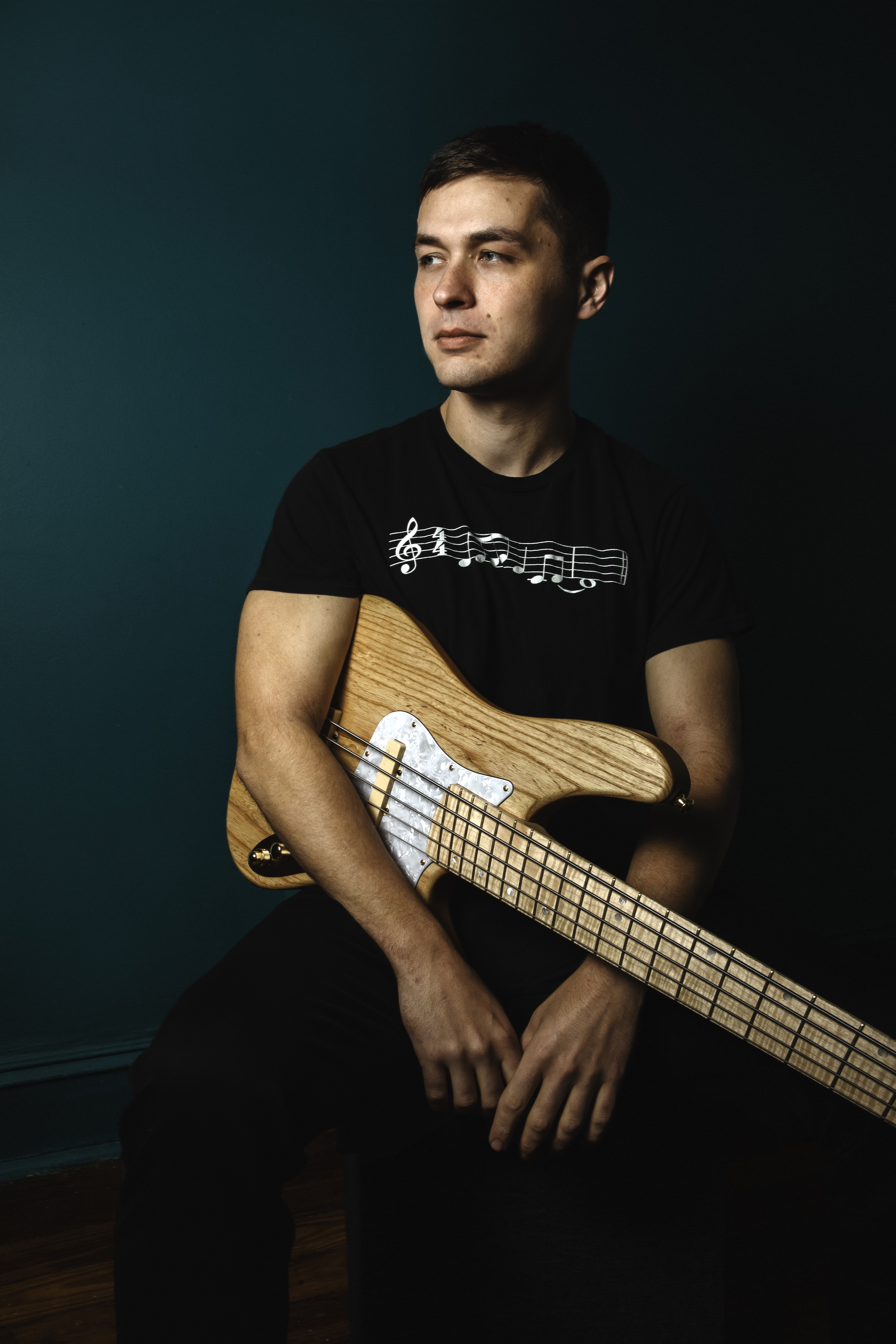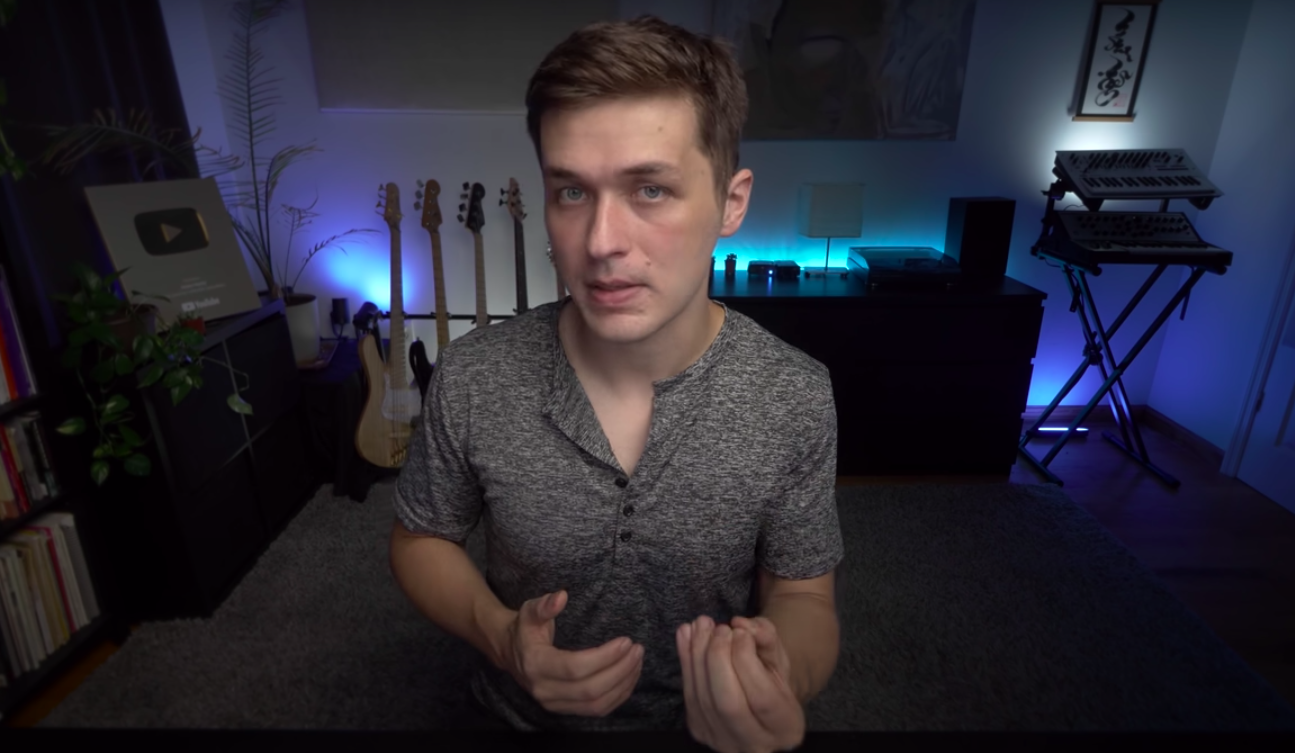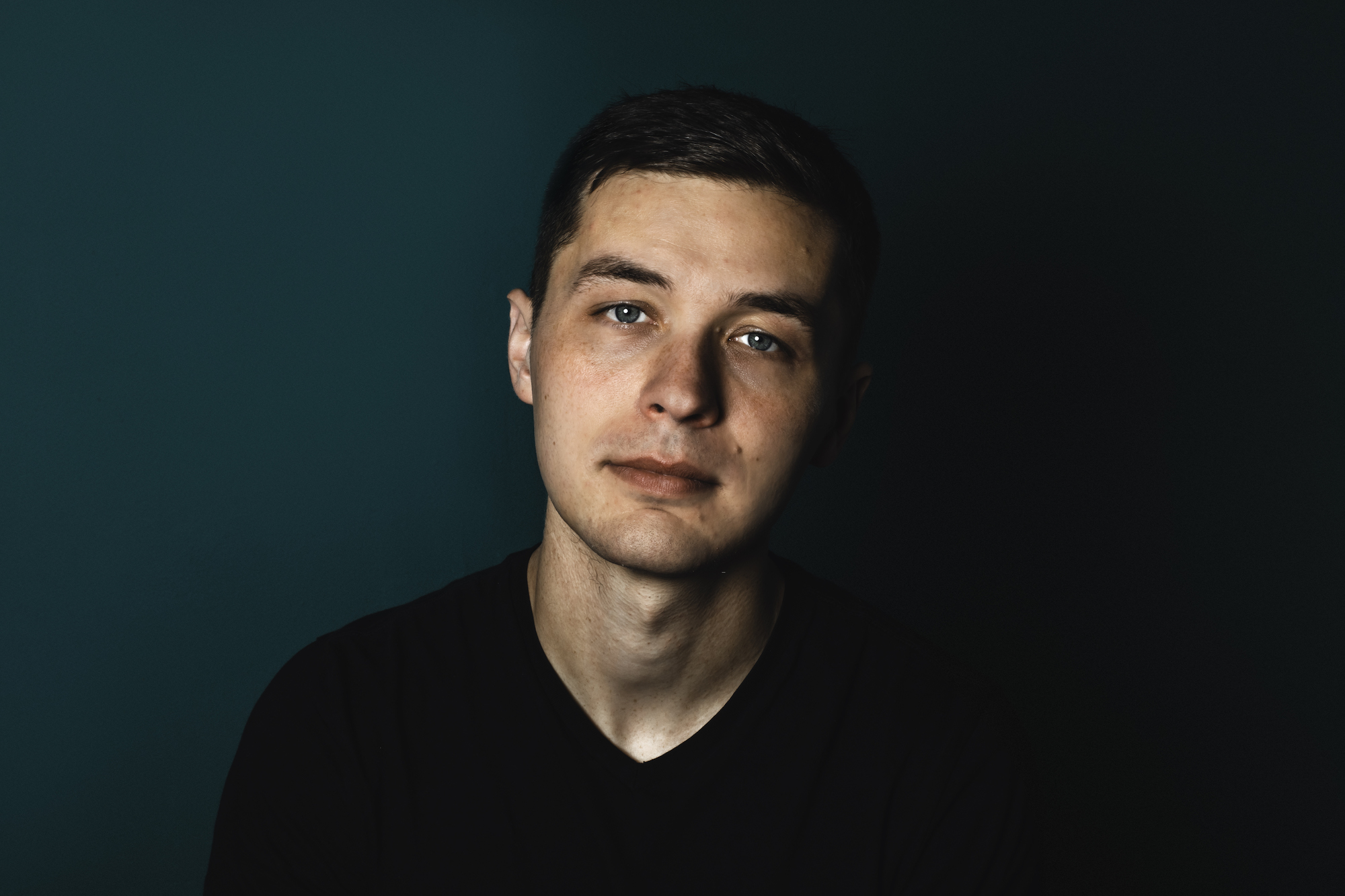To me, music theory is as foreign a concept as the intricacies of cooking meth, and I don’t think I’m alone in that. Sure, I have a basic grasp of scales, and I can read sheet music from my piano lesson days, but as soon as someone mentions the Dorian scale and E-flat-diminished-seventh chords, my eyes start to glaze over. So, when I found myself on the other side of an Adam Neely YouTube wormhole, I was a little surprised. Not only had I just sunk four hours of my life into content discussing those aforementioned topics, but also that I was thoroughly entertained by it. And I’m not alone.
Neely, 33, has garnered 1.25 million subscribers with his music theory-drenched video content. It’s all highly polished, cleverly edited and consistently funny. Some of his videos are simple Q&As or tongue-in-cheek deep dives into viral moments like the TikTok sea shanty fad, but Adam really shines in his on-camera essays. The wit and editing is still there and it’s accompanied by lush original backing tracks composed by Adam and his colleagues.
I asked his friend and collaborator, Ben Levin, what he thought had garnered Adam such a big following. “I think the key to Adam’s work, and it’s something maybe he takes for granted and can’t put his finger on, but he loves music in a very special way. I don’t think he realizes how contagious that is. Everything he does comes off as incredibly genuine, and I think it makes people realize, ‘dang, music is just so much bigger than I thought it was.’”
When Adam answers my Zoom call I have a moment where I have to double-check if I am indeed in a call and not just watching one of his videos. He’s sitting in his apartment in New York City against the same backdrop many of his fans would recognize, a room that’s tastefully decorated with plants, violet lights, a rack of guitars, various sizes of keyboards, and two striking abstract paintings. I tell him I’m surprised.
He shrugs, “Yea, this is my space. I don’t really ever leave.”

Student becomes the teacher
Neely grew up with music. His mother is a singer who performed avant-garde contemporary classical music and taught students in her house. Yet, it wasn’t until high school that Adam became enthralled with it.
“I did the thing that almost every other bassist does which is, ‘I want to join a band. Oh, they already have a guitarist, I guess I’ll play bass.’”
He soon found it wasn’t the short straw he thought it was. His mother brought him to a performance by the late Dave Brubeck and jazz bassist Christian McBride at the Library of Congress. “I knew about jazz. I thought it was fun, but this was the first time I realized that it was really fun. Just watching these two masters going back and forth laughing like there was some sort of inside joke I wasn’t a part of. I didn’t realize until then how life affirming music could be.”
Neely joined his high school jazz band and was encouraged by his teacher, Ms. Rackey. “I don’t shout her out enough,” he says. According to Ms. Rackey, he was already composing music back then. When asked about high school Adam, she laughed: “He is the most intuitive and creative person I have ever taught. But he would be writing music in class with five flats, and remember this is in high school. I’d say ‘Adam, just stop, we’re not going to be able to play that. Maybe turn it down a notch.’”
After rigorous practice and a couple of compositions under his belt, Adam landed in prestigious Berklee College of Music in Boston to study jazz composition. YouTube wasn’t the plan at first, although he was regularly posting to the channel. Old videos of a young Adam are still up for any interested fans.
“The plan was to play ‘cool’ jazz music, whatever that is, and teach,” he says. And for Adam, that was teaching at a university. “I was very much ready to be in academia. I knew what it meant to be a working musician from my family, it’s a grind, and they were able to support themselves through teaching, so I had my plan set. Stuff turned out a little differently, but I am teaching jazz and playing it.”
After a stint of playing gigs ranging from weddings to musical theater, Adam was beginning to burn out, and then suddenly a big portion of his paying work fell through. He was unsure what to do with all of his newly found free time, or where he’d find the next check to pay his rent. YouTube didn’t occur to him until a friend recommended it to him.
Neely knew a bit of the video editing program Final Cut, bought himself a DSLR camera, and in the same way, he threw himself into bass, he began producing videos. “I would categorize it as edutainment, or curiosity content, letting people discover things they don’t know,” he says, being sure to distinguish himself from other musical education channels that teach theory fundamentals like keys, notation, or the circle of fifths. Neely is too modest to make this comparison, but as Neil DeGrasse Tyson is to astrophysics, Neely is to music theory. He’s a communicator.

Schooling academia
Adam’s place on YouTube puts him firmly outside of the world of academia from which he came, a position that has allowed him to analyze the field with no strings attached. “There are elements of academia that I look up to, the research some of these people are doing, and of course, the teaching. But there are elements which I am very much against, and it’s slow to change.”
The most striking example of this is his video Music Theory and White Supremacy, where he and professor Phillip Ewell, who teaches music theory at Hunter College in New York and published a paper on the topic in early 2020, take on the white racial frame of the way music theory is taught. “The way we are approaching music is basically this fetishization of a certain 18th century western harmonic technique and that’s been used as a tool to prop up white music as superior,” Neely says. Something that is certainly holding the study and teaching of music theory back. It would be as if a linguistics professor only focused on English.
Many may have shied away from approaching matters of race in music theory. It’s a complex, and for some, a sensitive topic. “People really want to believe in race neutrality,” Ewell says in the video, “that it’s not about race. It’s just about good music.”
Ewell received backlash from his colleagues after publishing his paper. The University of Texas published 15 papers in a symposium response that Ewell wasn’t even invited to. Among these papers is an absurd racist rant in which one Timothy Jackson, a professor of music theory at the University of North Texas, accuses Ewell of anti-semitism, dismisses the work of Black musicians, and of all things, quotes a Wikipedia page. “I don’t even do that,” Neely says in regards to quoting the notoriously unreliable site, “and I make YouTube videos.”
Indeed, in stark contrast to Jackson, Neely takes on this nuanced topic with precision and cites his sources. “There’s an intense thirst to do research,” Levin, who’s also a Berklee grad, says about Adam. “You have to twist my arm to read some of the papers that he’s read. Nobody else in this music Youtube space is going to do the research [Neely] did, or the interviews he did for that video.”
At some point, Neely pulls an article from a 1918 newspaper to draw a parallel between today’s ridiculous decrying of hip hop and the culture surrounding it by talking heads like Ben Shapiro, and the earlier criticism of jazz as “devoid of harmonic and melodic instinct.” An argument that everyone can agree is ludicrous.
A new shit-stirring take on an old, tired subject
Tackling the huge topic of white supremacy in music theory requires a lot of contextual information, jumping back and forth between popular and academic critics, a discussion of Pythagoras, and much more. But Neely is able to keep all of this information digestible and entertaining through a well-crafted, 44-minute video. Interspersed between Neely and Ewell talking to the camera are renditions of Bach, examples of Indian music theory, and old clips of non-white music theoreticians. Sometimes he takes us outside as if he’s been pacing around New York City and discussing these ideas for hours. Instead of just plain old numbered sections, every chapter of the video is characterized by a jazzy piano chord and lick that tickles the ear.
This quality of production is consistent throughout much of Neely’s content. It’s all supremely edited and cohesively plotted for a one-man army. “There are very few music YouTubers that work with editors because you want someone who’s adept at editing, but also has an understanding of music theory. There is a very specific timing to how the edit should reflect the music that is in the video.”
You can feel that in his video on “The Girl From Ipanema” where he needs to cut between multiple arrangements of the storied bossa nova track. “Editing is very musical, working in Final Cut reminds me of working in Ableton Live (a digital audio workstation popular with electronic music producers) — it’s about creating a rhythmic flow. One cut of video should flow into the next just as one section of music should lead into the next.” Instead of bleeping curses, Neely plays a characteristic clip of a man yelling “bass,” which feels much like a little flair that an improvising trumpist might play over a jazz arrangement.
In this video Neely again shares a narrative that isn’t taught in music school. He points out in the beginning of the video that the version of “The Girl from Ipanema” that’s taught in The Real Book, the veritable jazz standards Bible, is a watered-down and white-washed version of the song. Through an in-depth dive into the context and history of bossa nova and the song itself, Neely shows that the original track from Brazil is actually more ambiguous and interesting than the Americanized version that would later be adopted into textbooks.
When asked about these videos, Neely says with a smirk, “I’ve always had kind of a shit-stirrer persona. I’m just doing my best to use that for good.”
Reaching tomorrow’s changemakers
There are other smaller ways in which Neely’s alternative viewpoint manifests itself. He covers topics that may never be covered in a classroom at Berklee like why there are no rap cover songs, the complex history of the USA’s national anthem, the arrest of Miles Davis, and the theory behind vaporwave, a genre of music where an existing song is simply slowed down or played backwards. “It’s the stuff I get excited about, stuff you wouldn’t normally get in music school. I didn’t get it in music school, but it does get you engaged with music in a deeper way.”
This is a reality that music students have known for decades. “Music school is always going to be behind because the people teaching it are not the people making the music that’s relevant to young people. For example, I’m calling it now: hyper-pop will be taught in music school 20 years from now.” Berklee, one of the leading music schools in the nation, didn’t incorporate jazz into their curriculum until the late ‘50s, almost 30 years after the genre was born.
But Neely isn’t all doom and gloom about the field. “I have a bumpy relationship sometimes with academia, but there are some great people working right now, and I’ll say that the future of these universities is in some very good hands.” Adam’s platform is pushing for that future in a big way. The amount of eyeballs he attracts with every new weekly video has a significant effect on the population of music students today.
For students, Neely’s a reminder that the stuffy academics can let loose, and for people like me, he demonstrates that engaging with music by way of theory doesn’t have to be reserved for students and teachers.
“He sees and hears things people cannot hear,” says his old high school teacher Ms. Rackey. “It’s a passion, and you can’t give that to people. Adam has a fire that I don’t believe is ever going to be put out.”




